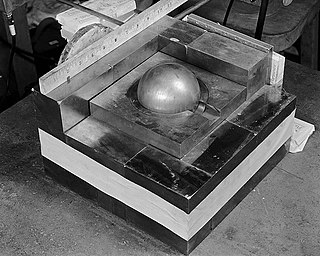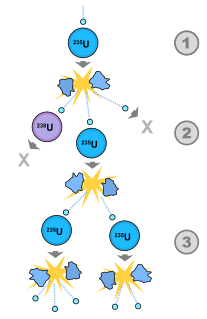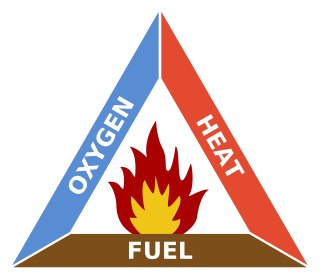| Look up criticality in Wiktionary, the free dictionary. |
Criticality may refer to:
| Look up criticality in Wiktionary, the free dictionary. |
Criticality may refer to:
In physics, critical phenomena is the collective name associated with the physics of critical points. Most of them stem from the divergence of the correlation length, but also the dynamics slows down. Critical phenomena include scaling relations among different quantities, power-law divergences of some quantities described by critical exponents, universality, fractal behaviour, and ergodicity breaking. Critical phenomena take place in second order phase transitions, although not exclusively.

In thermodynamics, a critical point is the end point of a phase equilibrium curve. The most prominent example is the liquid-vapor critical point, the end point of the pressure-temperature curve that designates conditions under which a liquid and its vapor can coexist. At higher temperatures, the gas cannot be liquefied by pressure alone. At the critical point, defined by a critical temperatureTc and a critical pressurepc, phase boundaries vanish. Other examples include the liquid–liquid critical points in mixtures.
A quantum critical point is a point in the phase diagram of a material where a continuous phase transition takes place at absolute zero. A quantum critical point is typically achieved by a continuous suppression of a nonzero temperature phase transition to zero temperature by the application of a pressure, field, or through doping. Conventional phase transitions occur at nonzero temperature when the growth of random thermal fluctuations leads to a change in the physical state of a system. Condensed matter physics research over the past few decades has revealed a new class of phase transitions called quantum phase transitions which take place at absolute zero. In the absence of the thermal fluctuations which trigger conventional phase transitions, quantum phase transitions are driven by the zero point quantum fluctuations associated with Heisenberg's uncertainty principle.

A critical mass is the smallest amount of fissile material needed for a sustained nuclear chain reaction. The critical mass of a fissionable material depends upon its nuclear properties, its density, its shape, its enrichment, its purity, its temperature, and its surroundings. The concept is important in nuclear weapon design.
Criticality, is the state of a nuclear chain reacting medium when the chain reaction is just self-sustaining, that is, when the reactivity is zero. More loosely, the term is used for states in which the reactivity is greater than zero.
A criticality accident is an uncontrolled nuclear fission chain reaction. It is sometimes referred to as a critical excursion, a critical power excursion or a divergent chain reaction.

Critical thinking is the analysis of facts to form a judgment. The subject is complex, and several different definitions exist, which generally include the rational, skeptical, unbiased analysis, or evaluation of factual evidence. Critical thinking is self-directed, self-disciplined, self-monitored, and self-corrective thinking. It presupposes assent to rigorous standards of excellence and mindful command of their use. It entails effective communication and problem-solving abilities as well as a commitment to overcome native egocentrism and sociocentrism.
Criticality index is mainly used in risk analysis. The Criticality Index of an activity (task) can be expressed as a ratio but is more often expressed as a percentage. During a simulation tasks can join or leave the critical path for any given iteration. The Criticality Index expresses how often a particular task was on the Critical Path during the analysis. Tasks with a high Criticality Index are more likely to cause delay to the project as they are more likely to be on the Critical Path. If a task does not exist for some iterations then it is marked as not being critical. For example, a task that existed for 50% of the iterations and was critical 50% of the time it existed would have a Criticality Index of 25%.
In operations research and engineering, a criticality matrix is a representation of failure modes along with their probabilities and severities.
| This disambiguation page lists articles associated with the title Criticality. If an internal link led you here, you may wish to change the link to point directly to the intended article. |

In nuclear physics and nuclear chemistry, nuclear fission is a nuclear reaction or a radioactive decay process in which the nucleus of an atom splits into smaller, lighter nuclei. The fission process often produces free neutrons and gamma photons, and releases a very large amount of energy even by the energetic standards of radioactive decay.

A nuclear chain reaction occurs when one single nuclear reaction causes an average of one or more subsequent nuclear reactions, this leading to the possibility of a self-propagating series of these reactions. The specific nuclear reaction may be the fission of heavy isotopes. The nuclear chain reaction releases several million times more energy per reaction than any chemical reaction.

A nuclear reactor, formerly known as an atomic pile, is a device used to initiate and control a self-sustained nuclear chain reaction. Nuclear reactors are used at nuclear power plants for electricity generation and in propulsion of ships. Heat from nuclear fission is passed to a working fluid, which in turn runs through steam turbines. These either drive a ship's propellers or turn electrical generators' shafts. Nuclear generated steam in principle can be used for industrial process heat or for district heating. Some reactors are used to produce isotopes for medical and industrial use, or for production of weapons-grade plutonium. Some are run only for research. As of early 2019, the IAEA reports there are 454 nuclear power reactors and 226 nuclear research reactors in operation around the world.

In nuclear engineering, fissile material is material capable of sustaining a nuclear fission chain reaction. By definition, fissile material can sustain a chain reaction with neutrons of thermal energy. The predominant neutron energy may be typified by either slow neutrons or fast neutrons. Fissile material can be used to fuel thermal-neutron reactors, fast-neutron reactors and nuclear explosives.

Uranium-235 (235U) is an isotope of uranium making up about 0.72% of natural uranium. Unlike the predominant isotope uranium-238, it is fissile, i.e., it can sustain a fission chain reaction. It is the only fissile isotope with a primordial nuclide found in significant quantity in nature.

Louis Alexander Slotin was a Canadian physicist and chemist who took part in the Manhattan Project. He was born and raised in the North End of Winnipeg, Manitoba. After earning both his Bachelor of Science and Master of Science degrees from the University of Manitoba, Slotin attended King's College London, where he obtained his doctorate in physical chemistry in 1936. Afterwards, he joined the University of Chicago as a research associate to help design a cyclotron. In 1942, he was invited to participate in the Manhattan Project.

The Fire Triangle or Combustion Triangle is a simple model for understanding the necessary ingredients for most fires.
A loss-of-coolant accident (LOCA) is a mode of failure for a nuclear reactor; if not managed effectively, the results of a LOCA could result in reactor core damage. Each nuclear plant's emergency core cooling system (ECCS) exists specifically to deal with a LOCA.

Chicago Pile-1 (CP-1) was the world's first nuclear reactor. On 2 December 1942, the first human-made self-sustaining nuclear chain reaction was initiated in CP-1, during an experiment led by Enrico Fermi. The secret development of the reactor was the first major technical achievement of the Manhattan Project, the Allied effort to create atomic bombs during World War II. Although the project's civilian and military leaders had misgivings about the possibility of a disastrous runaway reaction, they nevertheless decided due to time pressure to carry out the experiment in a densely populated area. It was built by the Metallurgical Laboratory at the University of Chicago, under the west viewing stands of the original Stagg Field. Fermi described the apparatus as "a crude pile of black bricks and wooden timbers".
In nuclear engineering, prompt criticality is said to be reached during a nuclear fission event if one or more of the immediate or prompt neutrons released by an atom in the event causes an additional fission event resulting in a rapid, exponential increase in the number of fission events. Prompt criticality is a special case of supercriticality.
Supercritical may refer to:
Natural uranium refers to uranium with the same isotopic ratio as found in nature. It contains 0.711% uranium-235, 99.284% uranium-238, and a trace of uranium-234 by weight (0.0055%). Approximately 2.2% of its radioactivity comes from uranium-235, 48.6% from uranium-238, and 49.2% from uranium-234.
Nuclear reactor physics is the branch of science that deals with the study and application of chain reaction to induce a controlled rate of fission in a nuclear reactor for the production of energy. Most nuclear reactors use a chain reaction to induce a controlled rate of nuclear fission in fissile material, releasing both energy and free neutrons. A reactor consists of an assembly of nuclear fuel, usually surrounded by a neutron moderator such as regular water, heavy water, graphite, or zirconium hydride, and fitted with mechanisms such as control rods that control the rate of the reaction.
The Clean and Environmentally Safe Advanced Reactor (CAESAR) is a nuclear reactor concept created by Claudio Filippone, the Director of the Center for Advanced Energy Concepts at the University of Maryland, College Park and head of the ongoing CAESAR Project. The concept's key element is the use of steam as a moderator, making it a type of reduced moderation water reactor. Because the density of steam may be controlled very precisely, Filippone claims it can be used to fine-tune neutron fluxes to ensure that neutrons are moving with an optimal energy profile to split 238
92U
nuclei – in other words, cause fission.

There have been two Tokaimura nuclear accidents at the nuclear facility at Tōkai, Ibaraki: on 11 March 1997, an explosion occurred in a Dōnen plant, and on 30 September 1999, a serious criticality accident happened in a JCO plant.

The demon core was a 6.2-kilogram (14 lb) subcritical mass of plutonium measuring 89 millimetres (3.5 in) in diameter, which was involved in two criticality accidents, on August 21, 1945 and May 21, 1946. The core was intended for use in a third World War II nuclear bomb, but remained in use for testing after Japan's surrender. It was designed with a small safety margin to ensure a successful explosion of the bomb. The device briefly went supercritical when it was accidentally placed in supercritical configurations during two separate experiments intended to guarantee the core was indeed close to the critical point. The incidents happened at the Los Alamos laboratory in 1945 and 1946, and resulted in the acute radiation poisoning and subsequent deaths of scientists Harry Daghlian and Louis Slotin. After these incidents the spherical plutonium core was referred to as the "demon core".
A pressurized heavy-water reactor (PHWR) is a nuclear reactor, commonly using natural uranium as its fuel, that uses heavy water (deuterium oxide D2O) as its coolant and neutron moderator. The heavy water coolant is kept under pressure, allowing it to be heated to higher temperatures without boiling, much as in a pressurized water reactor. While heavy water is significantly more expensive than ordinary light water, it creates greatly enhanced neutron economy, allowing the reactor to operate without fuel-enrichment facilities (offsetting the additional expense of the heavy water) and enhancing the ability of the reactor to make use of alternate fuel cycles. At the beginning of 2001, 31 heavy water cooled and moderated nuclear power plants were in operation, having a total capacity of 16.5 GW(e), representing roughly 7.76% by number and 4.7% by generating capacity of all current operating reactors.